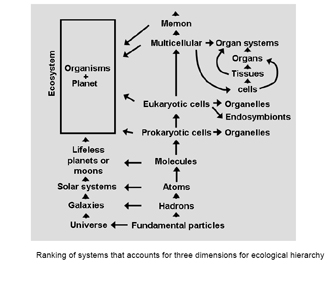Biology's take on the hierarchy of life has been pretty careless(!) up to now, says Jagers, and this hinders the discipline - but, luckily for you evolutionary biologists, this brand new Ph.D. says there is room for improvement and during his research Jagers says he came up with a hierarchy that is not only more consistent but also includes the classification of inorganic natural matter.
The ‘operator hierarchy' proposes the following:

The center column is the central axis that demonstrates how complexity increases from physical particles to chemical and subsequently organic particles (the organisms). The left column shows which systems develop from interactions between particles. The right column illustrates the increase in complexity within the particles.
The central column consists only of those particles that are independently formed from other particles directly beneath them in the hierarchy, the so-called ‘operators'. Jagers says he has also used the hierarchy of the operators to provide a solution to an age-old problem, the definition of life itself. According to his approach, something is a life form if it is an operator and is equally or more complex than a cell. Prospective technical life forms are also included in this definition. Jagers' operators are strictly arranged: the interactions between atoms lead to molecules; the interactions between molecules surrounded by a membrane lead to the cell, the interactions of cells form a multicellular organism, etc.
Jagers observes that new entities are formed according to a fixed system based on processes that in the thesis are called ‘closures'. Closure refers to the closing of a circular process or a circular structure. Each closure leads to a higher form of self-organization and a new recognizable entity: a new operator.
Following after the ‘memons’, the multicellulars with a neural network and not the ethnic groups near the Indus delta region, Jagers predicts that the next closure will lead to a life form in which the transfer of the blueprint by means of genes is replaced with the transfer of knowledge and collective experience by so-called ‘memes’.
In Jagers’ view, memes are codes that determine the structure of the brain. In turn, the structure of the brain determines someone’s knowledge. In this way, memes are carriers of brain structure and the corresponding knowledge, just like genes are carriers of protein recipes and the corresponding cell physiology.
The next life form will not necessarily develop by means of biological evolution, Jagers says, and he says a machine that shows intelligent behavior based on a neural network fulfills the definition of life. If this system can then also pass on its memory to the next generation then this involves a new step in evolution. "However, for the time being such robots still need humans to build them," he says.
"The operator hierarchy. A chain of closures linking matter, life and artificial intelligence" - the public defense of his doctoral thesis will take place at Radboud University Nijmegen on Sept. 6 2010 at 15:30 hrs. Doctoral thesis supervisor: Prof. Hub Zwart, Institute for Science, Innovation and Society (ISIS).





Comments